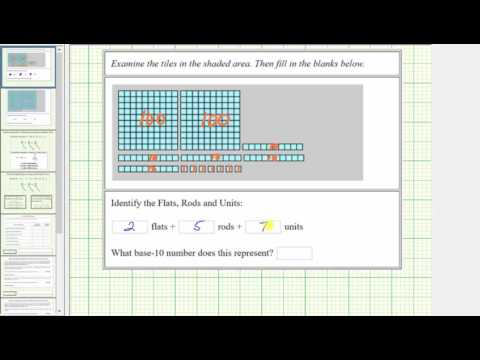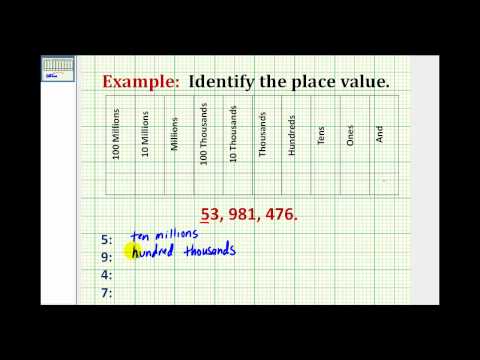1.15: Place Value in Whole Numbers
- Page ID
- 45753
Learning Objectives
- Use place value to define all digits of a whole number
Our number system is called a place value system because the value of a digit depends on its position, or place, in a number. The number has a different value than the number
. Even though they use the same digits, their value is different because of the different placement of the
and the
and the
.
Money gives us a familiar model of place value. Suppose a wallet contains three $100 bills, seven $10 bills, and four $1 bills. The amounts are summarized in the image below. How much money is in the wallet?
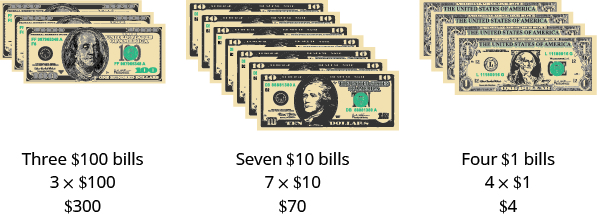
Find the total value of each kind of bill, and then add to find the total. The wallet contains $374.

Base-10 blocks provide another way to model place value, as shown in the image below. The blocks can be used to represent hundreds, tens, and ones. Notice that the tens rod is made up of ones, and the hundreds square is made of
tens, or
ones.
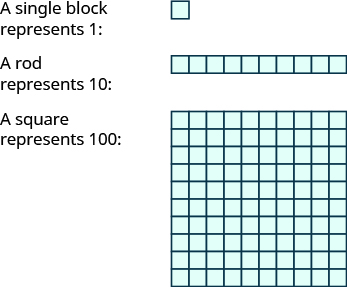
The image below shows the number modeled with base-10 blocks.
We use place value notation to show the value of the number .
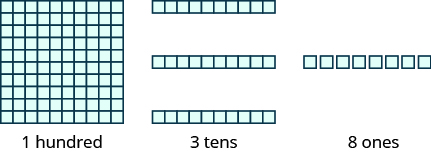

| Digit | Place value | Number | Value | Total value |
|---|---|---|---|---|
| hundreds | ||||
| tens | ||||
| ones | ||||
example
Use place value notation to find the value of the number modeled by the base-10 blocks shown.

[reveal-answer q=”664749″]Show Answer[/reveal-answer]
[hidden-answer a=”664749″]
There are hundreds squares, which is
.
There is tens rod, which is
.
There are ones blocks, which is
.

| Digit | Place value | Number | Value | Total value |
|---|---|---|---|---|
| hundreds | ||||
| tens | ||||
| ones | ||||
The base- blocks model the number
.
[/hidden-answer]
Try it
[ohm_question hide_question_numbers=1]143031[/ohm_question]
By looking at money and base- blocks, we saw that each place in a number has a different value. A place value chart is a useful way to summarize this information. The place values are separated into groups of three, called periods. The periods are ones, thousands, millions, billions, trillions, and so on. In a written number, commas separate the periods.
Just as with the base- blocks, where the value of the tens rod is ten times the value of the ones block and the value of the hundreds square is ten times the tens rod, the value of each place in the place-value chart is ten times the value of the place to the right of it.
The chart below shows how the number is written in a place value chart.
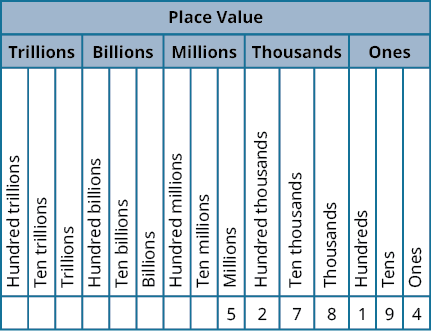
- The digit
is in the millions place. Its value is
.
- The digit
is in the hundred thousands place. Its value is
.
- The digit
is in the ten thousands place. Its value is
.
- The digit
is in the thousands place. Its value is
.
- The digit
is in the hundreds place. Its value is
.
- The digit
is in the tens place. Its value is
.
- The digit
is in the ones place. Its value is
.
example
In the number ; find the place value of each of the following digits:
[reveal-answer q=”17862″]Show Answer[/reveal-answer]
[hidden-answer a=”17862″]
Write the number in a place value chart, starting at the right.
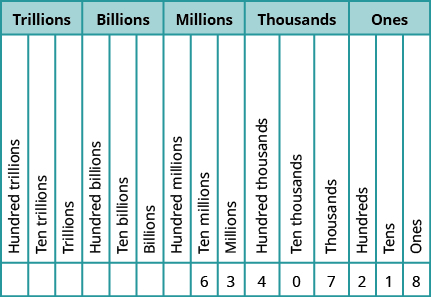
- The
is in the thousands place.
- The
is in the ten thousands place.
- The
is in the tens place.
- The
is in the ten millions place.
- The
is in the millions place.
[/hidden-answer]
try it
[ohm_question hide_question_numbers=1]130[/ohm_question]
The video below shows more examples of how to determine the place value of a digit in a number.
- Examples: Determining Place Value. Authored by: James Sousa (Mathispower4u.com). Located at: https://youtu.be/0-4rLGvVEOI. License: CC BY: Attribution
- Prealgebra. Provided by: OpenStax. License: CC BY: Attribution. License Terms: Download for free at http://cnx.org/contents/caa57dab-41c...cda5519c@9.757
- Determine a Whole Number Given Base 10 Blocks (Hundreds) . Authored by: James Sousa (Mathispower4u.com). Located at: https://youtu.be/KcXIxM6h9hk. License: CC BY: Attribution


